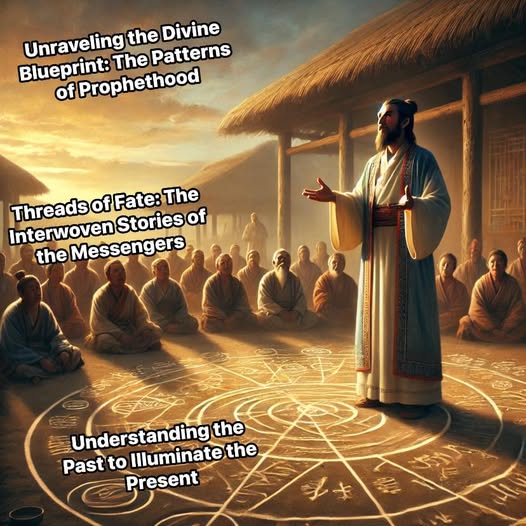
After returning to his village (see the previous post) , Kavi began applying the skills of logic and pattern recognition imparted by the sage. His analytical, creative, and objective thinking enabled him to weave together differing perspectives into a unified understanding. He had developed the ability to synthesize scattered facts into a coherent whole.
Seeking deeper truths, Kavi did not rely solely on observation but engaged in careful analysis. One day, as he sat by the shore, he reflected on the prophets and messengers whose stories the villagers often recounted. He wondered if a discernible pattern, a divine logic, governed their missions and the consequences of their efforts.
His inquiry began with the story of Prophet Abraham. Abraham called his people to worship one God and abandon idolatry, but they rejected him. When he departed with his family, divine retribution befell the city. Kavi recognized a recurring pattern: when a people rejected a divinely sent messenger, they often faced consequences. He saw this echoed in the narratives of Noah, whose people were destroyed by a flood, and Moses, whose adversary, Pharaoh, met his downfall. This pattern extended to Jesus and Muhammad—rejection of their messages resulted in repercussions for those who opposed them.
Mapping these events logically, Kavi identified a sequence: a messenger is sent to guide and purify, the people reject the message, and divine retribution follows. Yet, he also noted a shift after Abraham. Rather than sending prophets to every region, God directed Abraham to establish his two lineages in distinct locations—Mecca and Canaan (modern-day Palestine and Israel). Kavi saw this as a strategic move, laying the groundwork for a lasting legacy of monotheism. Abraham’s son Ishmael was settled in Mecca, while Isaac remained in Canaan. This division, Kavi realized, was not arbitrary but part of a larger divine plan to create a central place of worship and a unified call to monotheism.
Kavi then examined the roles of Ishmael and Isaac. Ishmael was chosen as a messenger (Rasool), tasked with delivering God’s message to his tribe in Mecca, while Isaac was appointed as a prophet (Nabee) with a broader role in guiding his lineage. Kavi observed that messengers were typically sent to communities that had deviated from monotheism, while prophets nurtured faith within existing believers. He realized this distinction explained why Ishmael’s message was accepted by his people, avoiding divine punishment, while Isaac’s role was not tied to a specific mission to a wayward tribe, promising to bless him and fulfill the covenant made with Abraham.
As Kavi explored further, he recognized the continuation of this pattern in the story of Moses—the first messenger from the Israelite lineage—who was sent to challenge Pharaoh and free his people from bondage. God had chosen the Israelites to establish a monotheistic center in Palestine, serving as a beacon to guide other nations toward His faith. To support his mission, Moses was granted miracles, such as turning his staff into a serpent, a powerful form of persuasion in an age where supernatural signs held great significance. Yet, despite these divine manifestations, Pharaoh remained defiant, ultimately leading to his downfall.
Turning to Jesus, Kavi observed that he was sent to reform the Israelites, who had strayed from Abraham’s teachings and neglected their duty to spread monotheism. Like Moses, Jesus was granted miraculous signs, including his virgin birth and his ability to preach from infancy. Yet, many Israelites rejected him, leading to divine consequences. Again, the pattern emerged—guidance was offered, rejection followed, and repercussions ensued.
Finally, Kavi examined the appointment of Muhammad as the final messenger. Over time, the descendants of Ishmael had also strayed, introducing idol worship into the religion of Abraham. In response, God chose Muhammad, an unlettered man, to challenge his people through the very art they prided themselves on—eloquence. The Quran became his miracle, persuading through its profound speech. Kavi noted another pivotal shift: after the Israelites rejected Jesus, the responsibility of spreading monotheism was transferred to the descendants of Ishmael. Muhammad’s mission marked the transition of sacred authority from Jerusalem to the Kaaba in Mecca, a move Kavi recognized as part of a divine plan ensuring that monotheism reached all of humanity.
Through meticulous analysis, Kavi uncovered the intricate patterns woven into the stories of the prophets. Their missions were not isolated events but threads in a grand, interconnected tapestry. Rejection of divine guidance led to retribution, while acceptance brought salvation. The strategic placement of Abraham’s descendants in Mecca and Canaan set the stage for a unified call to monotheism, culminating in Muhammad’s final message.
Eager to share his insights, Kavi illuminated these patterns for the villagers, helping them see the wisdom embedded in these ancient stories. He explained that the patterns revealed both the consequences of rejecting guidance and the enduring nature of God’s plan for humanity. By recognizing these truths, the villagers gained a deeper appreciation for the prophets’ messages and their timeless relevance.
In the end, Kavi’s journey of reflection and reason deepened not only his own understanding but also that of those around him. He learned to see beyond the surface, uncovering the divine logic that connected historical events to the infinite wisdom of the Creator. And in doing so, he found the peace he had long sought—not in the restless tides of desire, but in the calm depths of understanding.

